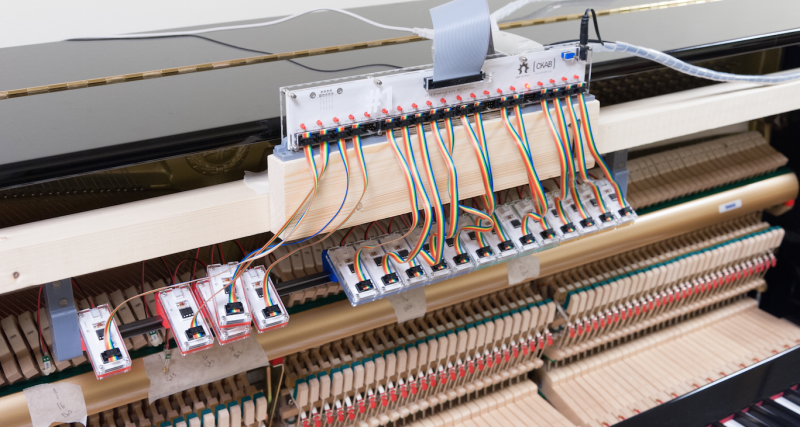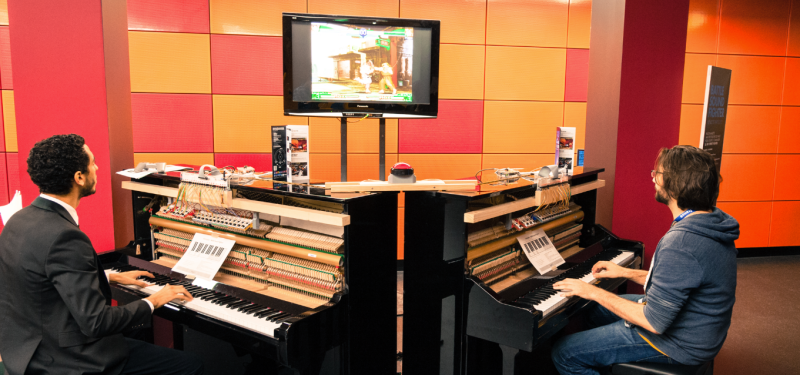What do you get when you mix dueling pianos with a 2D fighting game? Undoubtably some complex controls, but also an awesome platform for showmanship! The “Sound Fighter” installation by artists [Cyril] and [Eric] was built with the exact intention that two opposing parties could duke it out in a Street Fighter match with their piano playing abilities mapping into attack combos and dragon-punches.
In order to turn a piano into a glorified arcade stick, [Cyril] and [Eric] would need a way to register when and what notes were being played and then translate that data into commands for the fighting game itself. To start, they did their homework on the inner workings of different piano types. Whatever digital augmentation they were to design would have to work without inhibiting the piano’s function.
There were many possible methods of registering when the piano was being used and though several would have worked for their intended purpose, it took writing down and discussing the pros and cons of each sensor before they made a decision. Some of the options they considered included pressure sensors for the keys themselves, accelerometers to detect the movement of the individual hammers within the piano, and even a microphone to computationally analyze the sound heard from either instrument. In the end they chose to implement small and accurate piezo knock sensors tethered to the internal mechanism of each key. These could register both faint and strong notes when played without altering the natural sound of the instrument.

After deciding on a Street Fighter iteration for the PS2 to develop the rest of the project around, they had to play the actual game a bit to get a feel for the command list of moves. They wanted to conceive of a way to map the notes played to the controller, but not in the direct “key to button” sort of way. The idea was that if someone was good at playing piano, they would also be good at executing moves in game. So they had to sort out how groups of notes and chords would translate into moving the character or attacking.
I highly suggest checking out their in depth play-by-play as they built the installation from the ground up. In addition to being fascinating (they prepared this project in a fight against time for the reopening of a historical site in Paris), you’ll find that everything they developed is opened source. The completed installation is as awesome as it sounds. You can see it in action in an actual duel below:
















OK now THAT’S cool.
I’d like to see this developed into a whole piece. Maybe a fighting game isn’t the very best accompanying video for a real recital, but it sure looks like some interactive video going along with an accomplished pianist (or two) could make for some very interesting real art. In my opinion this is art too, but it’s more of an art-bite than a real work.
Still, that is pretty dang cool.
I want to see them play mech warrior or maybe some other mech games with pianos.
I’m not sure if there would be enough keys on a piano for all the buttons you need on a typical mech game. ZING!
So why didn’t they use an FFT and a couple of usb mic’s off ebay? I guess it wouldn’t look nearly as cool?
Nope (one of their aims was to be as non-invasive as possible so it was a fairly ideal solution).
As the [Had] article eludes to, on their website, they do discuss the various options available to them (including using a mic). They discount it on several grounds (none of them relating to the aesthetics, the big kicker was they were concerned about the processing latency) and instead opting for a more mechanical method.
Seriously, have a read of the original page as it’s a very well written walk through of the system (certainly compared to a lot of the “art installations” that this sort of activity tends to fall in).
haha, pretty amazing installation ;)
-> big up for the artists
Nb: last but not least, I’m not quite sure Cyril (aka @tchap) is indeed in the video ..
.. or maybe the question is “what happened with the hair cut ? ” ;p pj
keep up the good work foobarflies ;D
haha, pretty amazing installation ;)
-> big up for the artists
Nb: last but not least, I’m not quite sure Cyril (aka @tchap) is indeed in the video ..
.. or maybe the question is “what happened with the hair cut ? ” ;p pj
keep up the good work foobarflies ;D
This is Eric speaking, co-author of the installation. Thank you very much for the lovely writeup, we [Cyril and myself] are honored!
I would just like to make a correction on one point: we are not the ones performing in the video! The performers are actually Alvise Sinivia and Léo Jassef from the Conservatoire National de Paris, with whom we were lucky enough to work on the development of this project. Not only are they incredibly talented pianists, but they also had a lot of fun duelling, and the combination was a real treat for our eyes and ears.
Now let’s see them play Skullgirls!
As for FFT, with the innate over- and under-tones of a piano, can you tell whether C4 is hit individually or in a chord with a soft C5? Even picking out a peak at G4 would be an iffy proposition.
My problem with this is that when they were playing roughly 90% of the notes they played were unnecessary and just there to mask the notes they were actually using to play.
They should have called it “Pit Fighter”, but I’ll give them some slack for not coming up with that, since it might not be as good a pun in French.
Pretty cool project, though. Expensive, sure, but probably well below average for comparable art installations. The write-up is excellent, too.
This is an excellent performance, but played by professional piano players…
That made if fun to listen to, but what happens if non-musical but excellent streetfighter players would use the piano’s for a duel?
Mayhem for sure :)